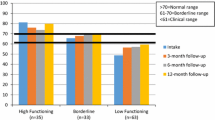Abstract
A study was conducted of the outcomes of all children and adolescents (N=114) with serious emotional disturbance who had been placed by school districts in residential treatment facilities for educational purposes over a three-year period. Both cost and outcome analyses were conducted. Cost analyses indicated a total annual expenditure in excess of $5 million, or $80,000 per youth per length of stay. Outcome analyses, consisting of ratings of outcomes and outcome interviews with special education directors, revealed that 63% of the youth had either made no or minimal progress, had been discharged with a negative outcome, or had run away. Positive outcomes were achieved in only 25% of the cases, measured by the students' return to school or placement into a vocational training program. Another 11% of the youth were making substantial progress. Analyses of the relationships between outcomes and cost revealed no relationship. However, positive outcomes were associated with shorter lengths of stay. Further, students in the positive outcome categories had more severe functioning deficits at intake than students in the negative outcome categories. The availability of community-based services for the student and family was the single most likely reason reported by special education directors for positive discharge status.
Similar content being viewed by others
References
Bloom, R. B., & Hopewell, L. R. (1982). Psychiatric hospitalization of adolescents and successful mainstream reentry.Exceptional Children, 48 352–357.
Brandenburg, N. A., Friedman, R. M., & Silver, S. E. (1989).Epidemiology of childhood psychiatric disorders: Prevalence findings from recent studies. Florida Research and Training Center for Children's Mental Health.
Burchard, J. D., & Clarke, R. T. (1990). The role of individualized care in a service delivery system for children and adolescents with severely maladjusted behavior.Journal of Mental Health Administration, 17 48–60.
Burns, B. J. (1989). Critical research directions for child mental health services.Conference proceedings: Children's mental health service and policy: Building a research base (pp. 8–13). Florida. Research and Training Center.
Durkin, R. P., & Durkin, A. B. (1975). Evaluating residential treatment programs for disturbed children. In M. Guttentag & E. L. Streuning (Eds.),Handbook of evaluation research (Vol. II; pp. 275–339). Beverly Hills, CA: Sage.
Jordan, D. D., & Hernandez, M. (1990). The Ventura planning model: A proposal for mental health reform.Journal of Mental Health Administration, 17 26–47.
Knitzer, J., Steinberg, Z., & Fleisch, B. (1990).At the schoolhouse door: An examination of programs and policies for children with behavioral and emotional problems. New York: Bank Street College of Education.
Knoff, H. M., & Batsch, G. M. (1990). The place of the school in community mental health services for children: A necessary interdependence.Journal of Mental Health Administration, 17 122–130.
Lewis, W. W. (1984). Ecological change: A necessary condition for residential treatment.Child Care Quarterly, 13 21–29.
Office of Technology Assessment (1986).Children's mental health: Problems and services background paper. Washington, D.C.
Stroul, B. J., & Friedman, R. M. (1986).A system of care for severely emotionally disturbed children and youth. Washington, D.C.: Child and Adolescent Service System Program Technical Assistance Center, Georgetown University.
Sunshine, J. H., Witkin, M. J., Atay, J. E., & Manderscheid, R. W. (1991). Residential treatment centers and other organized mental health care for children and youth. U.S. Dept. of Health and Human Services,Mental Health Statistical Note. No. 198, ADM 91-1891.
Whittaker, J. K., Kinney, J., Tracy, E. M., & Booth, C. (1988).Improving practice technology for work with high risk families: Lessons from the “Homebuilders” social work education project. Seattle, WA: Center for Social Welfare Research.
Whittaker, J. K., & Pecora, P. J. (1984). A research agenda for residential care. In T. Philpot (Ed.),Group care practice: The challenge of the next decade. Surrey, U.K.: Community Care/Business Press International.
Winsberg, B. G., Bialer, I., Kupietz, S., Botti, E., & Balka, E. B. (1980). Home vs. hospital care of children with behavior disorders.Archives of General Psychiatry, 37 413–416.
Author information
Authors and Affiliations
Rights and permissions
About this article
Cite this article
Hoagwood, K., Cunningham, M. Outcomes of children with emotional disturbance in residential treatment for educational purposes. J Child Fam Stud 1, 129–140 (1992). https://doi.org/10.1007/BF01321281
Issue Date:
DOI: https://doi.org/10.1007/BF01321281



